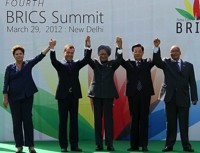Ever since Goldman Sachs economist Jim O’Neill defined the BRIC group of countries in 2001, policymakers have been closely watching the rise of the presumed leaders of the 21st century. And it was widely expected that as Brazil, Russia, China, India and recently added South Africa exercised growing power in global politics, they would also play a larger role in efforts to promote global development by using their own success as a template for smaller and lesser developed states. At their recent summit in New Delhi, the BRICS heads of state signaled their intention to take up that responsibility. The most prominent idea to come out of the meeting was the joint proposal for a BRICS-led and administered development bank, directed toward creating a “South-South” model of aid distribution.
For aid-weary Western policymakers, a development institution led and funded entirely by emerging countries is at first glance an ideal scenario. It would certainly relieve much of the pressures that the historical development practitioners have come under in an era of economic austerity. However, while the publicity and handshaking in New Delhi marked the first step toward their new aid partnership, the BRICS must figure out what exactly they seek to accomplish with this proposed institution. Unless they can figure out a common definition of what constitutes development aid, and the best practices to administer it, the proposed bank is doomed to fail before the delivery of its first check.
Unlike the members of the OECD, who use a common standard for development assistance, each of the BRICS countries has a different definition for what constitutes aid. Meanwhile, because most of their aid policies have emerged in the past 5-10 years as an outgrowth of their rising economic statures, the BRICS countries have had little experience in administering aid, planning a coherent strategy and building an effective distribution mechanism. Brazil, which by its own law is not allowed to conduct government-to-government transfers of money, relies on loans to Brazilian state-owned corporations operating in foreign countries to bolster its aid profile. Similarly, China uses a complex network of government agencies and state-backed enterprises (.pdf) to distribute money in recipient countries. Russia, having been a major donor in the past, is still struggling to maintain its own aid goals amid rising domestic concerns. India and South Africa both announced new aid agencies last year, but have shown little progress in terms of coherent plans.

